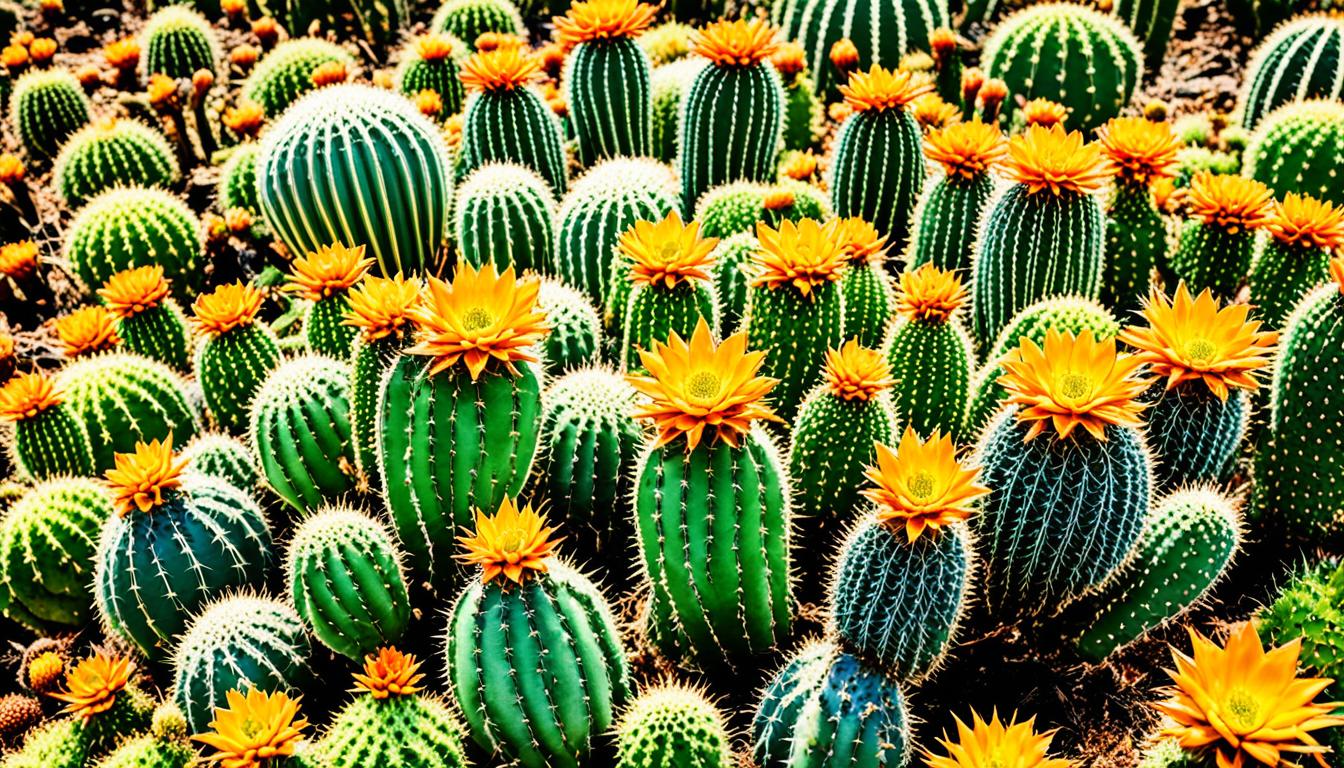Did you know Brazilian Cactus cleans the air? It’s also a beautiful addition indoors.
If you love plants or are new to them, this guide is for you. It has all you need to know about Brazilian Cactus.
We’ll tell you why it’s great for apartments. And we’ll cover its look and how it grows. You’ll learn how to make it thrive. Plus, get tips on spreading and keeping it healthy.
Key Takeaways:
- Brazilian Cactus is not only visually appealing but also has air-purifying properties.
- This complete guide will equip you with essential information on caring for and growing Brazilian Cactus.
- You will learn why Brazilian Cactus is a popular choice for apartment dwellers.
- Discover the unique appearance and growth habits of Brazilian Cactus.
- Get expert tips on providing the right conditions, propagation, and maintenance of Brazilian Cactus.
Why Do We Love the Brazilian Cactus For Apartments?
The Brazilian Cactus is perfect for your apartment. It’s liked for its air-cleaning, pet-safe, and small size.
Is the Brazilian Cactus Air-Purifying?
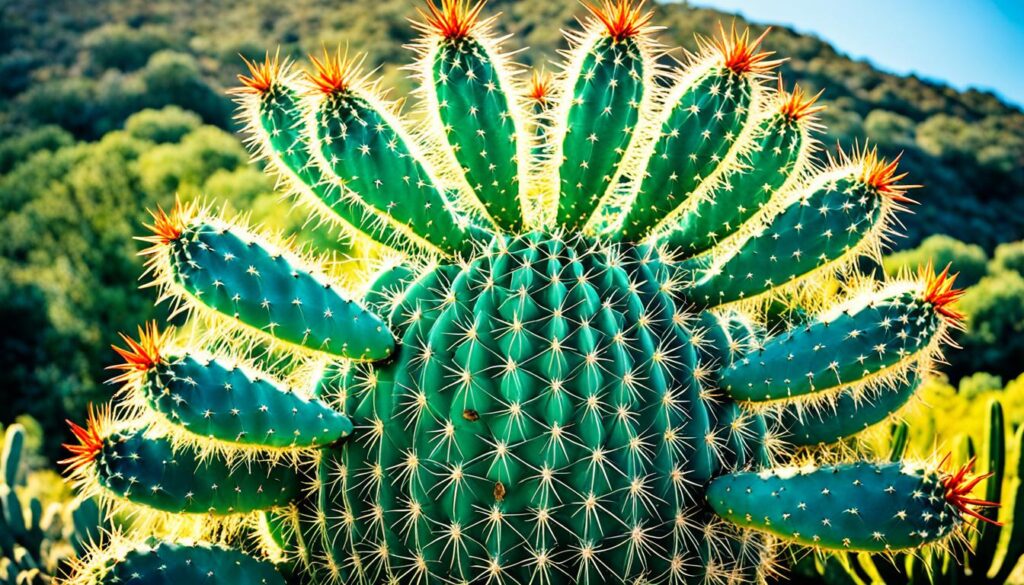
This cactus looks good and cleans the air. It takes in CO2 and gives out oxygen.
It removes toxins, making your home healthier.
Is the Brazilian Cactus Pet Friendly?
It’s great for pet owners. The Brazilian Cactus won’t harm your pets if they eat it.
You don’t have to worry about your pets’ safety with this cactus.
How Big Does the Brazilian Cactus Get?
The size of this cactus is perfect for small places. It grows up to 1 or 2 feet tall.
You can easily fit it on tables, shelves, or window sills. It doesn’t need much space.
So, the Brazilian Cactus is a top pick for living in apartments. It’s beautiful, safe for pets, and fits in small spaces well.
How to Grow a Brazilian Cactus – Learn to Grow this Indoor Beauty
Choosing the Right Pot and Soil
Choose the right pot with drainage holes to avoid water-logging. Use a cactus mix that drains well.
This keeps the roots dry and healthy.
Providing Adequate Light
Your cactus needs a bright spot near a window. But avoid strong direct sunlight to prevent harm.
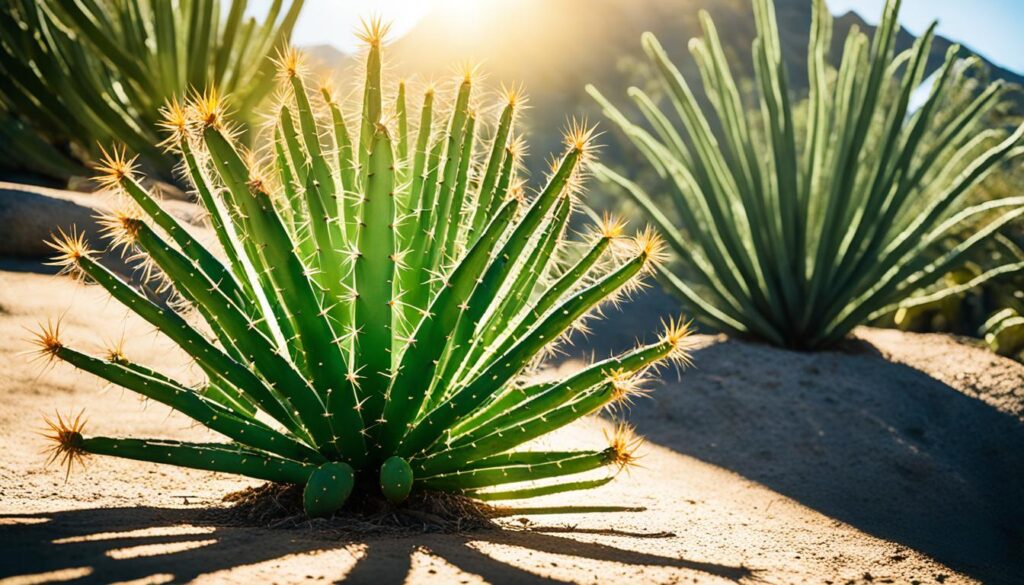
Watering and Humidity
Let the soil dry before watering the cactus well. Too much water can hurt it.
The cactus is okay with low humidity. Mist it if your home is very dry.
Nutrition and Fertilization
Feed your cactus with a special fertilizer every 4-6 weeks. Don’t fertilize when it’s resting.
Pruning and Maintenance
Keep your cactus neat by removing dead parts. Trim overgrown branches to keep its shape.
Check your cactus for pests or diseases often. If you find any, deal with them right away.
Propagation
You can make new plants from stem cuttings or offsets. Let the cuts dry before planting.
Keep the soil a bit wet in a warm spot until they root.
Monitoring for Pests and Diseases
Watch your cactus for bugs or sickness. Treat problems fast and adjust care as needed.
Appearance of Brazilian Cactus
The Brazilian Cactus is beautiful and looks unique. It often has a tall, skinny shape. The stems stand up straight and can be really tall. They look interesting because they have sections.
This cactus can be different colors. It might be very green or a bit blue. Some even look silver or gray. This makes them nice for decorating places.
The cactus has special spines. The spines can be long and sharp or short. They are found in groups on the stem. They make the cactus look nice and keep it safe.
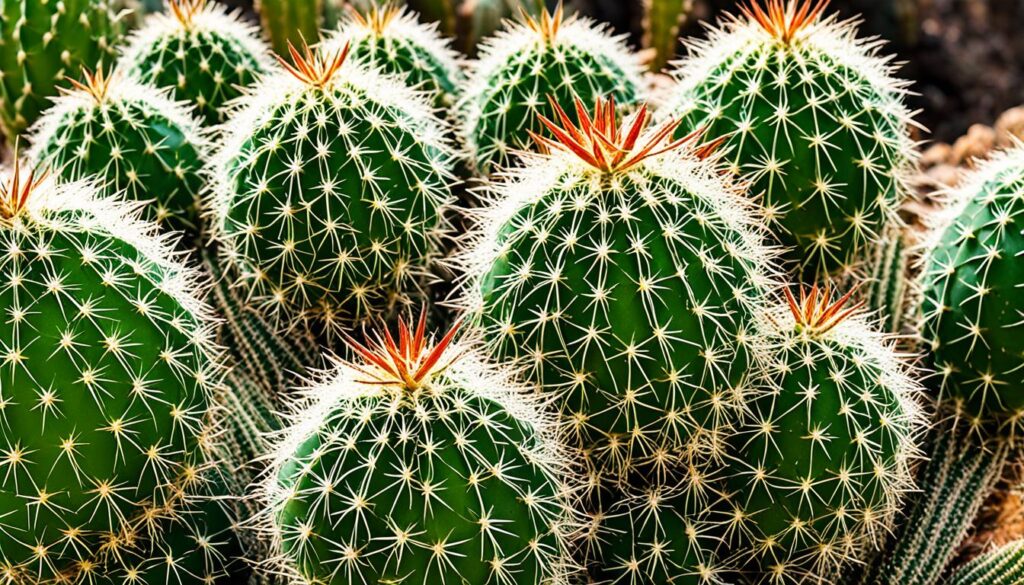
Light Requirements for Brazilian Cactus
Understanding how much light your Brazilian Cactus needs is very important. The right sunlight helps your plant grow and stay healthy.
Brazilian Cactus loves light but not too direct. A spot near a sunny window is great. Just make sure it’s not in direct sun for too long. It’s important to remember, though, it’s okay in some shade. Too little light, however, makes it weak.
Think about where to put your Brazilian Cactus. Places near south or west windows are best. But, if the room looks north or east, put the plant close to the window.
Mentioning that Brazilian Cactus can get used to different light is key. But don’t switch it too fast. That could stress or hurt the plant.
In short, your Brazilian Cactus does best in bright, indirect light. It can handle a bit of shade. The right spot near a window helps it thrive. With good light, your cactus will be happy and healthy.
Watering Requirements of the Brazilian Cactus
It’s very important to water the Brazilian Cactus right. Knowing this helps it grow well. Follow these tips:
Brazilian Cactus likes it dry and hates too much water. Let the soil fully dry before you water again. This could mean watering every two or three weeks.
When you water, soak the soil well. Use a watering can or soft stream to avoid hurting the spines.
Good drainage is key for these plants. Use soil that drains well and a pot with holes. This stops the roots from rotting.
Too much water can harm your plant. If you see yellow leaves, soft black roots, or a bad smell, you might be overwatering.
Not watering enough is also bad. Look for signs like wrinkled leaves, limp stems, or little growth.
Each Brazilian Cactus is different. Their water needs can change with the weather, where they are, and pot size. Watch your plant and water as needed.
To see what too much or too little water looks like in a Brazilian Cactus, look at the image below:
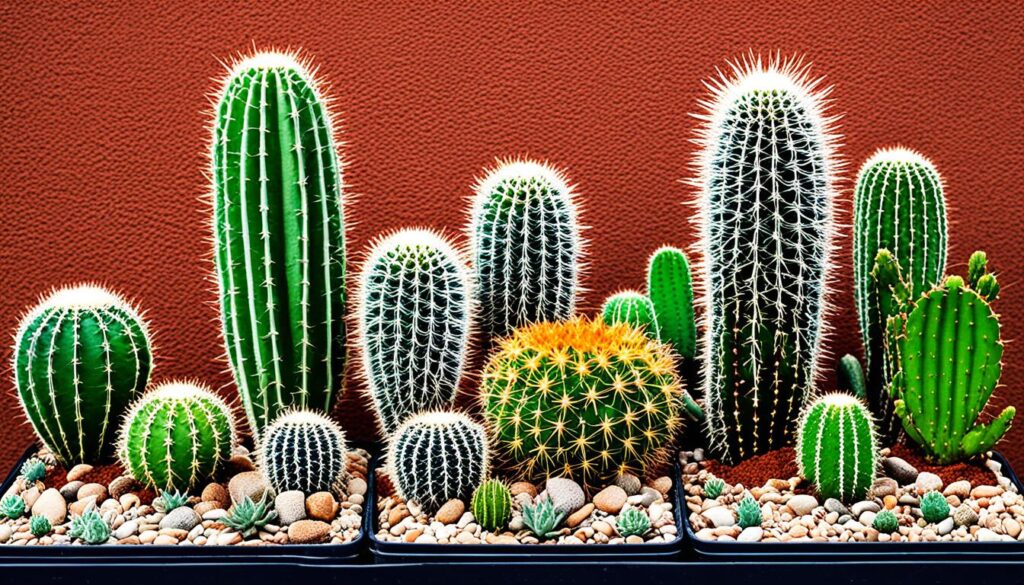
| Signs of Overwatering | Signs of Underwatering |
|---|---|
| Yellowing or wilting of leaves | Wrinkled or shriveled appearance |
| Mushy or blackened roots | Drooping or limp stems |
| Foul odor from the soil | Slow growth or stunted development |
Fertilizing a Brazilian Cactus
Brazilian Cacti need the right food to grow well. Fertilizer gives them the nutrients they need. Knowing what and how to feed them is key. This helps your cactus be healthy.
Recommended Fertilizer for a Brazilian Cactus
It’s important to pick the right food for your cactus. Use a balanced, slow-release fertilizer. It should have low to medium nitrogen. This keeps your cactus growing just right.
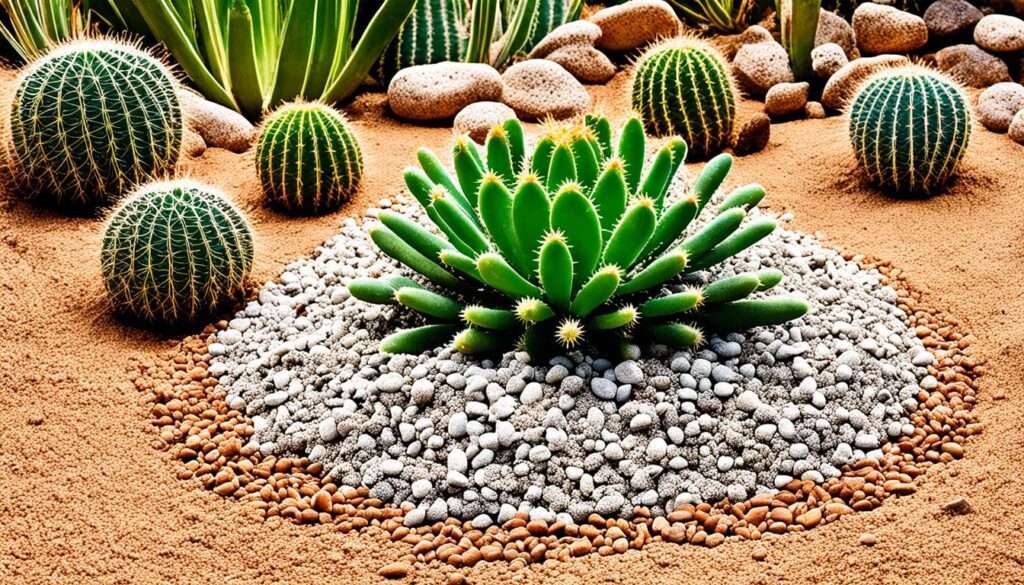
Feed your cactus in spring and summer. That’s when it grows. Follow the directions and don’t use too much.
Tip: Water your cactus before feeding it. This avoids burn and helps it eat better.
The right fertilizer mix is also key. Use one with equal parts N, P, and K. A 10-10-10 or 14-14-14 mix is good. This mix supports your cactus well.
Reminder: The right amount of nitrogen is crucial. Too much or too little can harm your cactus. Balance is important.
Feeding your cactus on schedule is a must. This keeps it from getting too little or too much food. Watch for signs like yellow leaves or weak growth. These could mean nutrient problems.
By sticking to the feeding rules, your Brazilian Cactus will bloom. It will look healthy and beautiful.
Potting a Brazilian Cactus
Getting the potting right is key for a happy Brazilian Cactus. It needs the correct pot size and soil. Also, knowing when to repot is important. Let’s look at what your cactus needs to thrive.
Choosing the Right Pot Size
Choosing the correct pot size is very important. A too small pot stops roots from growing well. But, a too big pot might cause too much water and root rot. Pick a pot that’s 1-2 inches bigger across than the root ball.
The pot’s depth matters too because this cactus has shallow roots. A 4-6 inch deep pot works best.
Using the Right Potting Mix for a Brazilian Cactus
The soil you use is super important for your cactus’s health. A mix that drains well is best. You can make a good mix with cactus soil, perlite, and coarse sand.
This kind of mix stops the soil from getting too wet. That way, there’s less chance of root rot or fungal disease.
Repotting When Necessary
As your cactus gets bigger, it might need a new pot. If roots are too crowded, or it’s not growing much, it’s time to repot.
When repotting, be gentle with the cactus. Check its roots and cut off any bad parts. Put the cactus in the new pot carefully. Make sure it stands straight. Then add more soil and press it down softly.
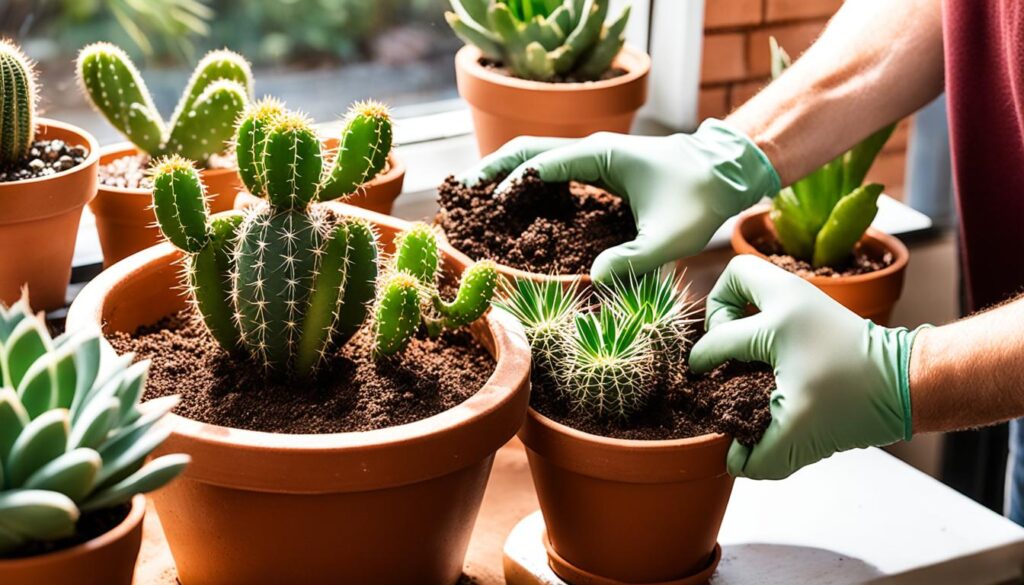
Propagating a Brazilian Cactus
Propagating Brazilian Cacti is exciting. You can grow your collection or share with friends. There are many ways to do it. Today, we’ll talk about two: stem cuttings and seeds. Let’s dive in and learn more. When propagating Brazilian cacti, using stem cuttings can yield quick results, as you can easily root them in soil or water. On the other hand, growing from seeds allows you to explore a wider variety of species and cultivate them from the very beginning. Additionally, if you’re interested in enhancing your indoor plant collection, don’t forget to check out some excellent african milk tree care tips to ensure your cacti thrive alongside other unique plants.
Stem Cuttings or Seeds?
Stem cuttings are quick and straightforward. Here’s how to do it:
- First, cut a healthy stem with a sharp, clean knife or shears.
- Let the cutting dry for a few days. This helps keep it healthy.
- Next, make a mix of sand, perlite, and cactus potting mix for planting.
- Plant the stem in this mix. Press around it so it stands up.
- Keep the cutting in a warm, bright place but out of direct sunlight.
- Water it a little, but not too much. You don’t want it to rot.
- Soon, in weeks or months, roots will grow. Now, it’s like a grown plant.
Seeds are another fun way. Here’s the process:
- Get fresh seeds from a trusted place or an adult plant.
- Create a mix perfect for cactus seeds to grow in.
- Put the seeds on top of the soil. Cover them lightly with more soil.
- Place them where it’s warm and bright but not in direct sun.
- Keep the soil moist with a spray bottle, being gentle.
- Waiting is required. Germination takes time, weeks to months, depending on conditions.
- Once they’ve grown some leaves, move them to their pots with special cactus mix.
Division of a Brazilian Cactus
Dividing a mature cactus is another way to propagate. Here are the steps:
- Take the plant out of its pot and separate the roots gently.
- Look for natural sections or baby plants that can stand on their own.
- Separate these parts with a clean knife or shears.
- Let these new pieces dry out for a few days before potting them.
- Put them in a warm, bright spot. Keep them away from direct sun.
- Water just enough to keep the soil moist, avoiding too much water.
- Take care of them, and soon they’ll grow into new plants.
Choosing stem cuttings, seeds, or division is great for more cacti. It’s rewarding to watch new plants grow from old ones. Be creative and enjoy growing these amazing cacti!
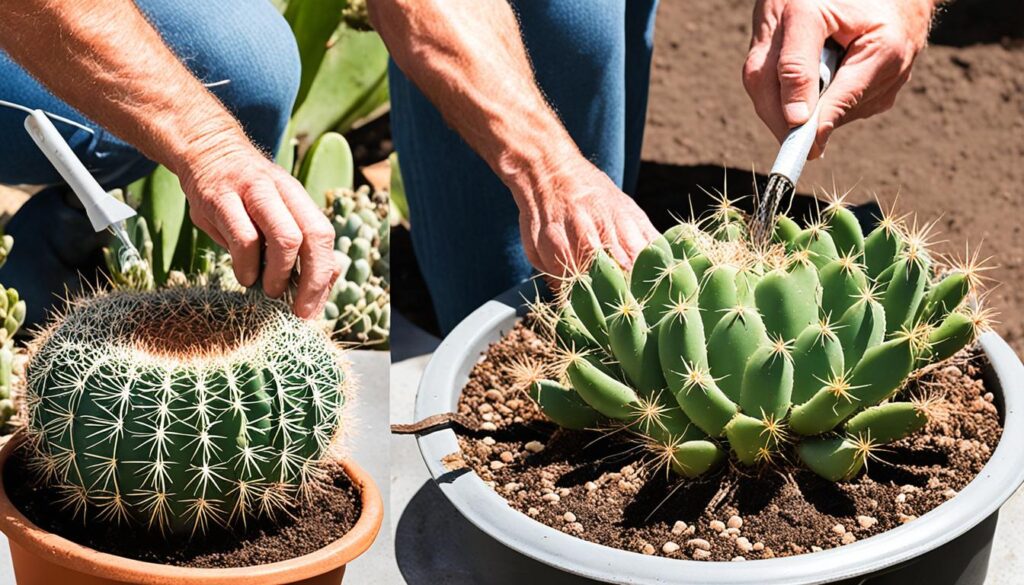
Growth and Development of the Brazilian Cactus
The Brazilian Cactus grows and changes a lot as it gets older. Knowing about these stages helps you take good care of it. It also lets you know what to expect as the cactus grows up.
In the beginning, the Brazilian Cactus grows roots. These roots soak up food from the soil. This helps the cactus grow. It’s important to use good soil and water the right amount.
Later, the cactus gets bigger. It grows new stems and branches. How fast it grows can change. It depends on things like the weather, light, and how healthy it is. Good light, enough water, and feeding it can make it grow strong.
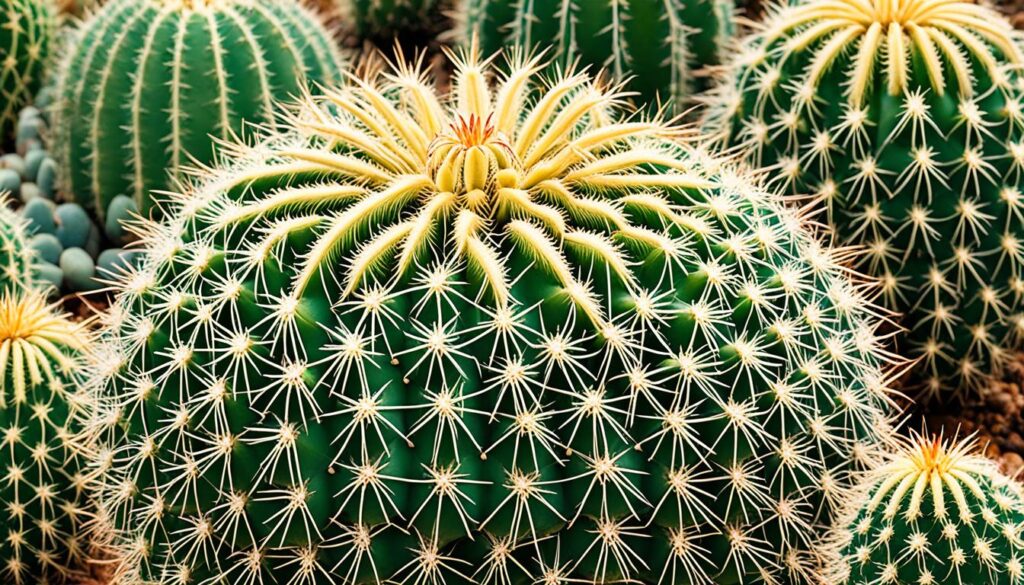
After a while, the cactus looks more grown up. You can see its special shape. Make sure to check it often. Look for any problems like missing food, bugs, or sickness.
When it’s fully grown, the cactus might flower. The flowers are pretty. They come in different colors and shapes. Seeing the cactus flower is very special. It shows your hard work in taking care of it.
To keep the cactus growing well, keep taking good care of it. Check it often. Give it the right amount of water and light. Sometimes, feed it a little. This helps it stay healthy for a long time.
Dealing with Pests and Diseases in the Brazilian Cactus
Brazilian Cactus is tough but still gets sick. With care, you can keep it healthy. I’ll talk about common pests and diseases. And how to prevent, find, and treat them.
Mealybugs, scale insects, and spider mites can harm your cactus. They eat the sap and make it weak. Check your cactus often for these pests.
Keeping your cactus clean helps prevent pests. Wipe its leaves with a wet cloth to remove dust.
If your cactus gets pests, keep it away from healthy ones. This stops the pests from spreading. Look for weird leaves as a sign.
Ladybugs and predatory mites eat pests. Adding them to your garden helps fight pests. It’s a natural way to keep pests away.
Sometimes, you might need chemicals to fight pests. Use insecticides made for cacti if pests are bad. But follow the directions and be careful.
Brazilian Cactus can get fungal infections from too much water. Don’t overwater it. Make sure the soil dries between waterings.
If you see signs of fungus, act fast. Cut off the sick parts with a clean tool. A cactus fungicide can stop the disease from spreading.
Checking your cactus regularly helps keep it healthy. Cleanliness and proper care are key. Follow these tips to keep your cactus beautiful and disease-free.
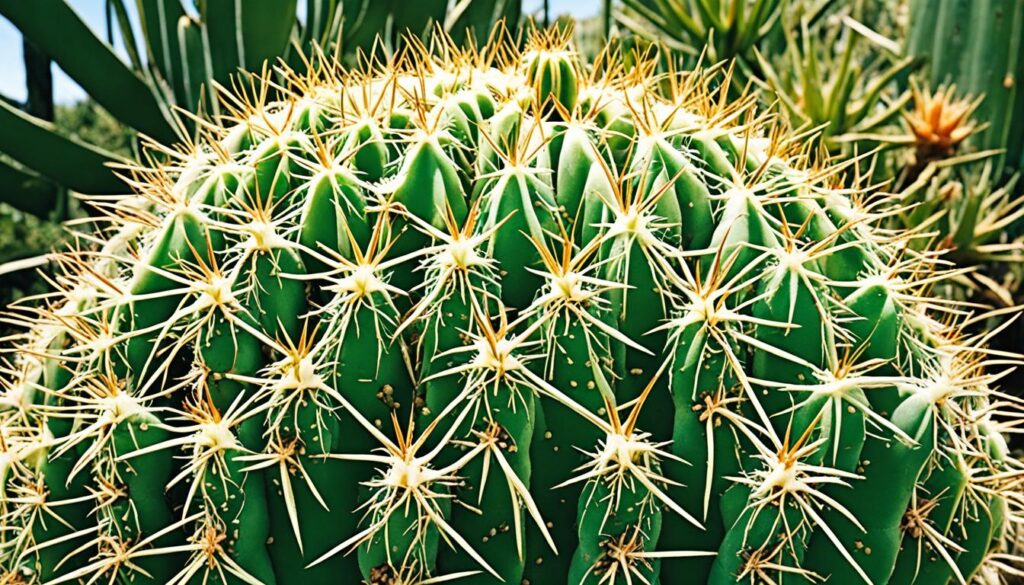
Common Brazilian Cactus Pests
Keeping your Brazilian Cactus healthy is important. You should know about pests that attack them. Preventing and finding pests early is key. Let’s look at common pests for Brazilian Cactus:
- Mealybugs: These are small, soft insects that hurt the cactus. They make the cactus turn yellow and weak. You can spot mealybugs by their white cottony look.
- Scale Insects: Scale insects can also harm your cactus. They hide under scale-like covers and look like bumps. These pests eat the cactus’s sap, which stops its growth and causes mold.
- Spider Mites: Spider mites are tiny and make webs. You find them on leaf bottoms. They cause yellow spots and leaves to fall. These pests love dry places and grow fast.
Check your Brazilian Cactus often for pests. Finding pests early helps you act fast. Using natural ways to fight pests works well. This includes helpful bugs or organic soaps.
| Common Brazilian Cactus Pests | Description |
|---|---|
| Mealybugs | Small, soft insects that are white and cottony. They eat plant sap, making the cactus yellow and weak. |
| Scale Insects | Pests under scale-like covers that look like bumps. They eat sap and stop growth, leading to mold. |
| Spider Mites | Tiny pests that make webs, found under leaves. They cause yellow spots and leaf drop. They multiply in dry environments. |
Natural Predators
Natural predators are key for controlling pests in Brazilian Cactus. They keep pests low without chemicals. So, they help keep your indoor garden healthy and balanced.
Isolate Infected Plants
It’s key to isolate sick plants to stop pests from spreading. By doing this quickly, you stop pests from harming more plants. You also get to treat the sick plant safely.
Chemical Treatment
Sometimes, we must use chemicals as a last option. This happens if other ways don’t stop the pests. When using chemicals, always follow the instructions closely. This keeps the plant safe.
Disease Prevention For Brazilian Cacti
Keeping Brazilian Cacti healthy is key. Follow some easy steps to keep them safe from disease. Here are important tips:
Maintain Good Hygiene
Keep your cacti clean to stop diseases. Wipe off dust and dirt from leaves and stems.
Use a soft cloth or gentle water spray for cleaning.
Proper Watering Practices
Too much water causes cactus diseases. Avoid keeping them too wet.
Make sure the soil drains well. Water only when the top soil feels dry.
Avoid Overfertilization
Too much fertilizer is bad for cacti. It causes nutrient problems and disease.
Stick to the cactus fertilizer schedule. Use the right amount for your cactus type.
Follow these tips for strong, healthy Brazilian Cacti. Prevention is the best way to avoid plant disease.
Tips for Maintaining Brazilian Cacti
Do you have Brazilian Cacti? They need care to stay healthy and live long. Here’s how to keep them happy:
Wiping Leaves
For shiny cacti, wipe the leaves to remove dust. Use a soft cloth or wet sponge gently. Be careful with the spines.
Outdoor Exposure
Sometimes, take your cacti outside. Pick a spot with some sun when it’s not too cold. They love light and fresh air. But, keep them away from very cold weather.
Adjusting Watering Schedule
Watering right is key for these desert plants. Water them less in cooler months. It’s okay to under-water them. Make sure the soil dries before watering again. Watch the humidity in your house, too.
Follow these tips for happy Brazilian Cacti. Regularly clean their leaves, let them enjoy the outside sometimes, and water them properly. They will grow well and look nice in your home.
Tips for Successful Overwintering of Brazilian Cactus
Keeping your Brazilian Cactus alive in winter is key. Here are some tips to help your cactus make it through.
To avoid overwatering, water less in winter. Let the soil dry a bit before watering again.
Brazilian Cactus loves light. In winter, light is scarce. Put it near a south window or under a grow light.
This cactus hates the cold. It can die if it gets too cold. Keep it in a place warmer than 50°F (10°C). Warm it up with other plants or a frost cloth.
Don’t fertilize in winter. The cactus is sleeping. Wait to fertilize until spring.
Brazilian Cactus doesn’t like too much humidity. Keep it away from very wet places.
Each cactus is different. Watch yours and see what it needs. With the right care, your cactus will stay healthy all winter.
Growing Brazilian Cactus from Seed
Growing Brazilian Cactus from seed is fun. You see the plant grow from the start. Just follow some easy steps to grow your own Brazilian Cactus.
First, get the seeds from grown-up Brazilian Cactus plants. Find ripe fruits or pods. Make sure they’re dry and ready. Then, take the seeds out gently.
Now, it’s time to get the seeds ready. Clean them by taking off any dirt or pulp. Wash the seeds with water. Let them dry for a day or two.
After the seeds dry, they need the right place to grow. Use a pot with special cactus soil. Put the seeds on top without pressing them in too deep. Cover the seeds lightly with soil.
Then, the seeds need enough water. Water the soil so it’s damp but not too wet. Cover the pot with clear plastic to keep moisture in.
Put the pot in a warm, bright place. Keep it away from direct sun. The best temperature is between 70-80°F (21-27°C). This helps the seeds start growing.
Check if the soil needs water often. You’ll see small plants start to appear in a few weeks. When they do, take off the plastic slowly.
Keep watering the baby plants the right way. The soil should be moist, not too wet. When they get bigger, move them to their pots. They like bright places but not direct sunlight.
With love and care, your Brazilian Cactus will grow big and strong. It takes months or years for them to be fully grown. Be patient.
Growing Brazilian Cactus from seed is amazing. You get to see life start and grow. By getting seeds ready, making sure they grow, and taking care of them, you can grow your own Brazilian Cactus. It’s so rewarding for those who love plants.
Varieties of Brazilian Cactus
Brazilian Cacti come in many types. Each type has its own special look and way of growing. Whether you love cacti or are just starting, trying different types can make your space more beautiful. Let’s look at some popular types of Brazilian Cacti:
The Echinopsis Cactus, or Easter Lily Cactus, has beautiful flowers. These flowers can be white, yellow, pink, or red. This Cactus makes any garden bright.
The Rhipsalis Cactus is another favorite. It hangs and looks elegant anywhere. Its long stems and soft leaves are great for hanging baskets or shelves. This plant loves bright, but not direct, light. It looks like a pretty green curtain.
The Hylocereus Cactus, also known as Dragon Fruit, grows on other plants. It is known for its tasty, healthy fruits. This Cactus gives you lovely flowers and a yummy snack.
These are just a few Brazilian Cactus types you might like. Each one has something special to offer. You might want a big bloomer like the Echinopsis, a lovely hanging Rhipsalis, or a fruiting Hylocereus. Brazilian Cacti have a lot to offer anyone. Growing these plants is fun and they add tropical beauty to your place.
FAQ
Q: Why is Brazilian Cactus a popular choice for apartments?
A: Brazilian Cactus is great for apartments because it cleans the air. It’s also safe for pets and doesn’t need much room.
Q: Is Brazilian Cactus air-purifying?
A: Yes, Brazilian Cactus cleans the air. It takes in toxins and gives out oxygen.
Q: Is Brazilian Cactus pet friendly?
A: Yes, Brazilian Cactus is safe for pets. It won’t harm cats or dogs.
Q: How big does Brazilian Cactus get in indoor settings?
A: Indoor Brazilian Cactus stays small. It can be a few inches to a foot tall.
Q: How do I choose the right pot and soil for my Brazilian Cactus?
A: Pick a pot with holes for water to escape. Use fast-draining soil for cacti.
Q: What are the light requirements for Brazilian Cactus?
A: Brazilian Cactus loves bright, indirect sunlight. Keep it near a window but out of direct sun.
Q: How often should I water my Brazilian Cactus?
A: Water Brazilian Cactus only when the soil is dry. The needs depend on your plant.
Q: What are the signs of overwatering and underwatering in Brazilian Cactus?
A: Too much water causes root rot and leaf yellowing. Not enough makes leaves shrivel.
Q: What type of fertilizer is recommended for Brazilian Cactus?
A: Use a balanced, water-soluble fertilizer made for succulents. Follow the package directions.
Q: How do I pot a Brazilian Cactus correctly?
A: Choose a draining pot bigger than the roots. Use potting mix for cacti and succulents.
Q: What are the different methods of propagating Brazilian Cactus?
A: You can use stem cuttings or seeds. Cuttings are easiest; let them root.
Q: How does Brazilian Cactus grow and develop?
A: Brazilian Cactus grows slowly. It gets new stems and sometimes flowers.
Q: What are common pests and diseases that can affect Brazilian Cactus?
A: It may get bugs like mealybugs or diseases like root rot.
Q: How do I deal with common pests that affect Brazilian Cactus?
A: Use ladybugs or neem oil for pests. Isolate sick plants and use chemicals as a last option.
Q: What are some tips for preventing diseases in Brazilian Cacti?
A: Keep plants clean and don’t overwater. Be careful with fertilizer to avoid plant stress.
Q: How do I maintain a healthy Brazilian Cactus?
A: Clean the leaves and give it some outdoor sun. Adjust watering with the seasons.
Q: What are some tips for successful overwintering of Brazilian Cactus?
A: Reduce water and light in winter to mimic rest time. Keep it warm.
Q: How can I grow Brazilian Cactus from seed?
A: Collect seeds, prepare them, and use well-draining soil. Keep them moist.
Q: What are the different varieties of Brazilian Cactus?
A: There are many kinds, like Christmas Cactus and Easter Cactus. Each is unique.
Source Links
- https://greg.app/plant-care/pilosocereus-chrysostele-brazilian-cactus

- https://bioone.org/journals/cactus-and-succulent-journal/volume-90/issue-3/015.090.0308/An-Illustrated-Field-Guide-as-a-Tool-for-Conservation-of/10.2985/015.090.0308.full

- https://www.pinterest.com/pin/discover-the-beauty-of-brazilian-prickly-pear-cactus–50947039523516040/

